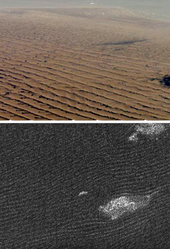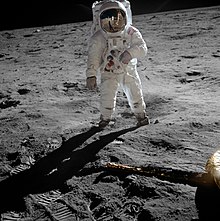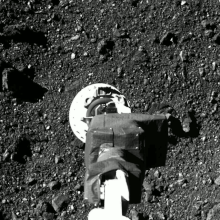행성 표면
Planetary surface행성 표면은 특정 유형의 천문학 물체에 있는 외부 지각의 고체(또는 액체) 물질이 대기 또는 외부 공간에 접촉하는 곳입니다.행성 표면은 지구 행성, 왜행성, 자연 위성, 미행성 및 다른 많은 작은 태양계 천체들을 포함한 행성 질량의 고체 물체에서 발견됩니다.[1][2][3]행성 표면에 대한 연구는 표면 지질학으로 알려진 행성 지질학 분야이지만, 행성 지도학, 지형학, 지형학, 대기 과학, 그리고 천문학을 포함한 많은 분야의 초점입니다.랜드(또는 접지)는 액체가 없는 행성 표면을 가리키는 용어입니다.착륙이라는 용어는 물체가 행성 표면과 충돌하는 것을 묘사하기 위해 사용되며, 일반적으로 물체가 손상되지 않고 붙어 있는 상태로 유지될 수 있는 속도입니다.
분화된 물체에서 표면은 지각이 행성 경계층과 만나는 곳입니다.이 아래에 있는 것은 해저 또는 해저로 간주됩니다.작은 가스 왜성뿐만 아니라 별과 가스 거성을 포함한 슈퍼 지구보다 더 질량이 큰 대부분의 물체는 가스, 액체, 고체를 포함한 상들 사이에서 연속적으로 변화합니다.따라서 일반적으로 표면이 결여된 것으로 간주됩니다.
행성 표면과 표면 생물은 육지 위를 이동하고 공기를 마시도록 진화한 이 종의 주요 서식처이기 때문에 인간에게 특별한 관심을 가지고 있다.그러므로 인간의 우주 탐사와 우주 식민지화는 그들에게 많은 초점을 맞추고 있다.인간은 지구와 달의 표면을 직접 탐험했을 뿐이다.우주의 광대한 거리와 복잡성은 심지어 지구에 가까운 물체들의 직접적인 탐사를 위험하고 비싸게 만든다.이와 같이, 다른 모든 탐사는 우주 탐사선을 통해 간접적으로 이루어졌습니다.
플라이바이 또는 궤도에 의한 간접적인 관측은 현재 행성 표면의 구성과 특성을 확인하기에 충분한 정보를 제공하지 않습니다.알려진 것의 대부분은 천체 분광학이나 샘플 리턴과 같은 기술의 사용에서 비롯된다.착륙선 우주선은 화성과 금성의 표면을 탐사했다.화성은 이동식 표면 탐사선에 의해 표면이 탐사된 유일한 다른 행성이다.타이탄은 착륙선에 의해 탐사된 행성 질량의 유일한 비행성 물체이다.착륙자들은 433 Eros(2001년), 25143 이토카와(2005년), Tempel 1(2005년), 67P/추류모프-게라시멘코(2014년), 162173 Ryugu(2018년), 101955 Benu(2020년)를 포함한 여러 작은 물체를 탐사했다.표면 샘플은 달(1969년 반환), 25143 이토카와(2010년 반환), 162173 류구, 101955 베누에서 수집되었다.
배포 및 조건
행성 표면은 태양계 내부에서부터 소행성대, 가스 거대 행성의 자연 위성, 그리고 그 너머 해왕성 횡단 물체까지 태양계 전역에서 발견됩니다.표면 상태, 온도 및 지형은 표면 자체에서 종종 발생하는 알베도를 비롯한 여러 가지 요인에 의해 크게 달라집니다.표면 조건의 측정에는 표면적, 표면 중력, 표면 온도 및 표면 압력이 포함됩니다.지표면 안정성은 풍류 과정, 수문학, 침강, 화산 활동, 퇴적물 또는 지진 활동을 통한 침식에 의해 영향을 받을 수 있다.어떤 표면은 역동적인 반면 다른 표면은 수백만 년 동안 변하지 않습니다.
탐색
거리, 중력, 대기 조건(극저기압 또는 극고기압) 및 알려지지 않은 요인 때문에 탐사는 비용이 많이 들고 위험합니다.이것은 행성 표면의 초기 탐사를 위해 우주 탐사선이 필요하다.많은 탐사선이 정지해 있고 연구 범위가 제한되어 있으며 일반적으로 외계 표면에서 단기간 생존하지만 이동식 탐사선(로버)은 더 넓은 표면적을 조사했다.샘플 귀환 임무는 과학자가 유인 임무를 보내지 않고도 지구상의 외계 표면 물질을 연구할 수 있게 하지만, 일반적으로 낮은 중력과 대기를 가진 물체에서만 가능하다.

과거의 미션
이 섹션은 확인을 위해 추가 인용문이 필요합니다.(2020년 9월 (이 및 ) |
최초로 탐사된 외계 행성 표면은 1959년 Luna 2에 의한 달 표면이었다.인간이 최초로 외계 표면을 탐사한 것은 달이었고, 아폴로 프로그램은 1969년 7월 20일 최초의 문워크를 포함했으며, 외계 표면 샘플을 지구로 성공적으로 귀환시켰다.베네라 7호는 1970년 12월 15일 탐사선이 다른 행성에 처음으로 착륙한 것이다.화성 3호는 "연착륙"하여 1972년 8월 22일 화성에서 데이터를 반환했으며, 화성 최초의 탐사선은 1997년 화성 패스파인더였으며, 화성 탐사 탐사선은 2004년부터 이 붉은 행성의 표면을 연구해 왔다.NEAR Shoemaker는 소행성에 연착륙한 첫 번째 사람 - 2001년 2월 433 Eros였고, 하야부사는 2010년 6월 13일 25143 이토카와에서 샘플을 반환한 첫 번째 사람이었다.호이겐스는 2005년 1월 14일 타이탄에서 연착륙하여 데이터를 반환했다.
포보스의 표면 탐사를 목적으로 한 샘플 귀환 임무인 포보스-그룬트 등 많은 시도가 실패했다.
표면 재료
태양계에서 가장 흔한 행성 표면 물질은 물 얼음으로 보인다.표면 얼음은 수성만큼 태양에 가깝게 발견되지만 화성 너머에서 더 많이 발견됩니다.다른 표면에는 암석, 레골리스 및 냉동 화학 원소와 화학 화합물의 조합으로 된 고체 물질이 포함됩니다.일반적으로 얼음은 서리선 너머의 행성 표면을 지배하며, 태양 근처에는 암석과 레골리스가 지배적이다.광물과 하이드레이트는 또한 많은 행성 표면에 소량 존재할 수 있습니다.
드문 표면 발생

표면 액체는, 지구에 풍부하지만(세계 대양이 표면 액체의 가장 큰 몸체는) 다른 곳에서는 드물지만, 눈에 띄는 예외는 알려진 가장 큰 탄화수소 호수 시스템을 가지고 있는 타이탄입니다. 지표수는 지구에 풍부하고 알려진 모든 형태의 생명체에 필수적이며, 따뜻한 화성 경사면에는 계절적인 흐름이 존재한다고 생각됩니다.d는 다른 행성계의 거주 가능 구역에서 발생한다.
화산활동은 지질활동체 표면의 용암과 같은 흐름을 일으킬 수 있다(가장 큰 것은 Io의 Amirani(볼카노) 흐름이다).지구의 화성암 중 많은 것들이 화산 마그마와 물의 존재와 같은 다른 곳에서는 보기 드문 과정을 통해 형성된다.달 탐사선에 의해 화성에서 발견된 올리빈과 헤마타이트와 같은 표면 광물 퇴적물은 화성 표면에 과거 안정된 물이 있었다는 직접적인 증거를 제공한다.
물을 제외하고, 많은 다른 풍부한 표면 물질들은 유기물일 뿐만 아니라 생명체의 존재로 인해 형성되었기 때문에 태양계에서 지구에만 고유한 것이다. 이러한 물질들은 탄산염, 석회암, 식생 및 인공 구조물을 포함하지만, 탐사선 탐사로 인해 존재하는 인공 물체 목록도 참조한다.n개의 외부 표면).
외계 유기 화합물
태양계 전체의 물체에서 점점 더 많은 유기 화합물이 발견되고 있다.외계 생명체의 존재를 나타낼 것 같지는 않지만, 알려진 모든 생명체는 이러한 화합물에 기초하고 있다.복잡한 탄소 분자는 다양한 복잡한 화학적 상호작용을 통해 형성되거나 작은 태양계 물체와의 충돌을 통해 전달될 수 있으며 탄소 기반 생명체의 "구성 요소"를 형성하기 위해 결합될 수 있습니다.유기화합물은 종종 휘발성이기 때문에, 행성 표면에서 고체 또는 액체로서의 지속성은 지질학적 시간 척도에 따른 특별한 상황을 통해 보존된 많은 양의 유기물질 또는 외인성 사워의 본질적인 원천(물체의 내부로부터와 같은) 또는 잔류물을 나타내기 때문에 과학적으로 흥미롭다.ce(과거 또는 최근 [6]다른 오브젝트와의 충돌 등)방사선은 유기물 탐지를 어렵게 해 태양에 가까운 대기 없는 물체 탐지를 극도로 [7]어렵게 한다.
발생할 수 있는 예로는 다음이 있습니다.
- Tholins – 명왕성-차론,[8] [9]타이탄, 트리톤,[10] 에리스,[11] 세드나,[12] 28978 Ixion,[13] 90482 오르쿠스,[14] 24[15][16] 테미스를 포함한 많은 트랜스 해왕성 천체
- 메탄포화물(CH4·5.75HO2) – 오베론, 티타니아, 움브리엘, 명왕성, 90482 오르쿠스, 혜성 67P
화성에서
지상으로봇에서 채취한 샘플과 궤도를 도는 인공위성의 분광학을 포함한 화성 탐사는 생명체를 찾는 데 있어 생물 징후가 될 수 있는 복잡한 유기 분자의 존재를 밝혀냈다.
온세레스
엔셀라두스에서
혜성 67P에서
우주탐사선 필레는 혜성 67P [24][25][26]표면에서 다음과 같은 유기화합물을 발견했다.
무기 재료

다음은 두 개 이상의 행성 표면에서 발생하는 비방사성 표면 물질 목록과 태양으로부터의 거리 순으로 나타낸 것입니다.일부는 분광학이나 궤도 또는 플라이바이에서 직접 영상을 통해 검출되었다.
- 얼음(HO
2) – 수성(극성), 지구-달 시스템,[27] 화성(극성);케레스[28] 및 일부 소행성(예: 24 테미스,[29] [30]목성 위성 – 유로파, 가니메데,[31] 칼리스토, 트리톤, 토성 위성 – 타이탄과 엔셀라두스, 천왕성 위성 – 미란다, 움브리엘, 오베론; 명왕성-샤론 시스템, 하우메아, 500cusion, 9048 등) - 규산염 암석 – 수성, 금성, 지구, 화성, 소행성, 가니메데, 칼리스토, 달, 트리톤
- 레골리스 – 수성;[32] 금성,[33] 지구-달계; 화성(및 그 위성 Phobos와 Deimos), 소행성(4 베스타[34] 포함)타이탄
- 질소 얼음(N) – 명왕성-카론,[35] 트리톤,[36] 카이퍼 벨트 물체, 플루티노스
- 황(S) – 수성; 지구; 화성; 목성의 위성 – Io 및 Europa
희귀 무기질
- 소금 – 지구, 화성, 케레스, 유로파 및 목성 트로이 [37]목성, 엔셀라두스[38]
- 클레이 – 지구; 화성;[39] 케레스 및 템펠 [41]1을 포함한[40] 소행성; 유로파[42]
- 모래 – 지구, 화성, 타이탄
- 탄산칼슘(CaCO
3)– 지구, 화성[43][44] - 탄산나트륨(NaCO
2
3) – 지구, 세레스[45][46][47]
카본 아이스
지형
일반적인 표면 특징은 다음과 같습니다.
- 충돌 크레이터(두꺼운 대기를 가진 물체에서는 더 드물지만, 화성의 헬라스 평원에서는 가장 크다)
- 금성, 지구, 화성 및 타이탄에서 발견된 모래 언덕
- 화산과 저온 화산
- 릴리스
- 산맥(4 베스타의 [citation needed]레아실비아가 가장 높다.
- 급경사
- 협곡과 계곡(화성의 마리네리스 계곡 중 가장 큰 계곡)
- 동굴
- 금성, 지구, 달, 화성에서 발견된 용암 동굴
가스 거대 기업의 표면
일반적으로 가스 거대기업은 표면이 없는 것으로 간주되지만, 암석이나 다양한 종류의 얼음 또는 금속 수소로 이루어진 액체 핵을 가지고 있을 수 있다.하지만, 만약 존재한다면, 그 중심핵은 실제로 표면으로 여겨질 만큼 충분한 질량을 포함하지 않는다.일부 과학자들은 대기압이 지구 표면의 대기압과 같은 1bar인 지점을 행성의 표면으로 간주한다.[1]
인생
행성 표면은 과거 또는 현재의 외계 생명체가 존재하는지 조사됩니다.토마스 골드는 [53]표면뿐만 아니라 천체의 표면 아래에 생명체와 소위 깊은 생물권이 존재할 가능성을 높임으로써 그 분야를 확장했습니다.
표면우월주의와 표면주의
게다가, 토마스 골드는 생명체를 표면 우월주의로 [53]탐구할 때 아래가 아닌 표면에만 초점을 맞춘 과학을 비판했습니다.
이와 유사하게 지표면 경계와 영역 공간 옹호, 특히 화성 같은 우주 식민지화에 초점을 맞춘 것은 금성 [54][55]표면 위 같은 대기권과 잠재적 대기권 거주에 대한 관심을 무시한 채 표면주의로 명명되었다.
「 」를 참조해 주세요.
레퍼런스
- ^ Meyer, Charles; Treiman, Allanh; Kostiuk, Theodor (May 12–13, 1995). Meyer, Charles; Treiman, Allan H.; Kostiuk, Theodor (eds.). Planetary Surface Instruments Workshop (PDF). Houston, Texas. p. 3. Bibcode:1996psi..work.....M. Retrieved 2012-02-10.
- ^ "Planetary Surface materials". Haskin Research Group. Retrieved 2012-02-10.
- ^ Melosh, Jay (August 2007). Planetary Surface Processes. Cambridge Planetary Science. p. 9. ISBN 978-0-521-51418-7.
- ^ "Venera 9's landing site". The Planetary Society. Retrieved 16 September 2020.
- ^ "Venera 9's landing site". The Planetary Society. Retrieved 16 September 2020.
- ^ Ehrenfreund, P.; Spaans, M.; Holm, N. G. (2011). "The evolution of organic matter in space". Philosophical Transactions of the Royal Society A: Mathematical, Physical and Engineering Sciences. 369 (1936): 538–554. Bibcode:2011RSPTA.369..538E. doi:10.1098/rsta.2010.0231. PMID 21220279.
- ^ Anders, Edward (1989). "Pre-biotic organic matter from comets and asteroids". Nature. 342 (6247): 255–257. Bibcode:1989Natur.342..255A. doi:10.1038/342255a0. PMID 11536617. S2CID 4242121.
- ^ Grundy, W. M.; Cruikshank, D. P.; Gladstone, G. R.; Howett, C. J. A.; Lauer, T. R.; Spencer, J. R.; Summers, M. E.; Buie, M. W.; Earle, A. M.; Ennico, K.; Parker, J. Wm.; Porter, S. B.; Singer, K. N.; Stern, S. A.; Verbiscer, A. J.; Beyer, R. A.; Binzel, R. P.; Buratti, B. J.; Cook, J. C.; Dalle Ore, C. M.; Olkin, C. B.; Parker, A. H.; Protopapa, S.; Quirico, E.; Retherford, K. D.; Robbins, S. J.; Schmitt, B.; Stansberry, J. A.; Umurhan, O. M.; et al. (2016). "The formation of Charon's red poles from seasonally cold-trapped volatiles". Nature. 539 (7627): 65–68. arXiv:1903.03724. Bibcode:2016Natur.539...65G. doi:10.1038/nature19340. PMID 27626378. S2CID 205250398.
- ^ McCord, T. B.; Hansen, G. B.; Buratti, B. J.; Clark, R. N.; Cruikshank, D. P.; D’Aversa, E.; Griffith, C. A.; Baines, E. K. H.; Brown, R. H.; Dalle Ore, C. M.; Filacchione, G.; Formisano, V.; Hibbitts, C. A.; Jaumann, R.; Lunine, Jonathan I.; Nelson, R. M.; Sotin, C. (2006). "Composition of Titan's surface from Cassini VIMS". Planetary and Space Science. 54 (15): 1524–1539. Bibcode:2006P&SS...54.1524T. doi:10.1016/j.pss.2006.06.007.
- ^ Grundy, W. M.; Buie, M. W.; Spencer, J. R. (October 2002). "Spectroscopy of Pluto and Triton at 3–4 Microns: Possible Evidence for Wide Distribution of Nonvolatile Solids". The Astronomical Journal. 124 (4): 2273–2278. Bibcode:2002AJ....124.2273G. doi:10.1086/342933.
- ^ Brown, Michael E., Trujillo, Chadwick A., Rabinowitz, David L. (2005). "Discovery of a Planetary-sized Object in the Scattered Kuiper Belt". The Astrophysical Journal. 635 (1): L97–L100. arXiv:astro-ph/0508633. Bibcode:2005ApJ...635L..97B. doi:10.1086/499336. S2CID 1761936.
{{cite journal}}: CS1 maint: 여러 이름: 작성자 목록(링크) - ^ Barucci, M. A.; Cruikshank, D. P.; Dotto, E.; Merlin, F.; Poulet, F.; Dalle Ore, C.; Fornasier, S.; De Bergh, C. (2005). "Is Sedna another Triton?". Astronomy & Astrophysics. 439 (2): L1–L4. Bibcode:2005A&A...439L...1B. doi:10.1051/0004-6361:200500144.
- ^ Boehnhardt, H.; et al. (2004). "Surface characterization of 28978 Ixion (2001 KX76)". Astronomy and Astrophysics Letters. 415 (2): L21–L25. Bibcode:2004A&A...415L..21B. doi:10.1051/0004-6361:20040005.
- ^ de Bergh, C. (2005). "The Surface of the Transneptunian Object 9048 Orcus". Astronomy & Astrophysics. 437 (3): 1115–20. Bibcode:2005A&A...437.1115D. doi:10.1051/0004-6361:20042533.
- ^ Omar, M. H.; Dokoupil, Z. (May 1962). "Solubility of nitrogen and oxygen in liquid hydrogen at temperatures between 27 and 33°K". Physica. 28 (5): 461–471. Bibcode:1962Phy....28..461O. doi:10.1016/0031-8914(62)90033-2.
- ^ Rivkin, Andrew S.; Emery, Joshua P. (2010). "Detection of ice and organics on an asteroidal surface". Nature. 464 (7293): 1322–1323. Bibcode:2010Natur.464.1322R. doi:10.1038/nature09028. PMID 20428165. S2CID 4368093. (PDF 버전은 2018년 2월 28일 액세스).
- ^ Voosen, Paul (2018). "NASA rover hits organic pay dirt on Mars". Science. doi:10.1126/science.aau3992.
- ^ Mukbaniani, O. V.; Aneli, J. N.; Markarashvili, E. G.; Tarasashvili, M. V.; Aleksidze, N. D. (2015). "Polymeric composites on the basis of Martian ground for building future mars stations". International Journal of Astrobiology. 15 (2): 155–160. doi:10.1017/S1473550415000270. ISSN 1473-5504.
- ^ a b Eigenbrode, Jennifer L.; Summons, Roger E.; Steele, Andrew; Freissinet, Caroline; Millan, Maëva; Navarro-González, Rafael; Sutter, Brad; McAdam, Amy C.; Franz, Heather B.; Glavin, Daniel P.; Archer, Paul D.; Mahaffy, Paul R.; Conrad, Pamela G.; Hurowitz, Joel A.; Grotzinger, John P.; Gupta, Sanjeev; Ming, Doug W.; Sumner, Dawn Y.; Szopa, Cyril; Malespin, Charles; Buch, Arnaud; Coll, Patrice (2018). "Organic matter preserved in 3-billion-year-old mudstones at Gale crater, Mars" (PDF). Science. 360 (6393): 1096–1101. Bibcode:2018Sci...360.1096E. doi:10.1126/science.aas9185. ISSN 0036-8075. PMID 29880683. S2CID 46983230.
- ^ Vu, Tuan H; Hodyss, Robert; Johnson, Paul V; Choukroun, Mathieu (2017). "Preferential formation of sodium salts from frozen sodium-ammonium-chloride-carbonate brines – Implications for Ceres' bright spots". Planetary and Space Science. 141: 73–77. Bibcode:2017P&SS..141...73V. doi:10.1016/j.pss.2017.04.014.
- ^ McCord, Thomas B; Zambon, Francesca (2018). "The surface composition of Ceres from the Dawn mission". Icarus. 318: 2–13. Bibcode:2019Icar..318....2M. doi:10.1016/j.icarus.2018.03.004.
- ^ De Sanctis, M. C.; Ammannito, E.; McSween, H. Y.; Raponi, A.; Marchi, S.; Capaccioni, F.; Capria, M. T.; Carrozzo, F. G.; Ciarniello, M.; Fonte, S.; Formisano, M.; Frigeri, A.; Giardino, M.; Longobardo, A.; Magni, G.; McFadden, L. A.; Palomba, E.; Pieters, C. M.; Tosi, F.; Zambon, F.; Raymond, C. A.; Russell, C. T. (2017). "Localized aliphatic organic material on the surface of Ceres". Science. 355 (6326): 719–722. Bibcode:2017Sci...355..719D. doi:10.1126/science.aaj2305. PMID 28209893. S2CID 16758552.
- ^ a b Khawaja, N; Postberg, F; Hillier, J; Klenner, F; Kempf, S; Nölle, L; Reviol, R; Zou, Z; Srama, R (2019). "Low-mass nitrogen-, oxygen-bearing, and aromatic compounds in Enceladean ice grains". Monthly Notices of the Royal Astronomical Society. 489 (4): 5231–5243. Bibcode:2019MNRAS.489.5231K. doi:10.1093/mnras/stz2280. ISSN 0035-8711.
- ^ Jordans, Frank (30 July 2015). "Philae probe finds evidence that comets can be cosmic labs". The Washington Post. Associated Press. Archived from the original on 23 December 2018. Retrieved 30 July 2015.
- ^ "Science on the Surface of a Comet". European Space Agency. 30 July 2015. Retrieved 30 July 2015.
- ^ Bibring, J.-P.; Taylor, M.G.G.T.; Alexander, C.; Auster, U.; Biele, J.; Finzi, A. Ercoli; Goesmann, F.; Klingehoefer, G.; Kofman, W.; Mottola, S.; Seidenstiker, K.J.; Spohn, T.; Wright, I. (31 July 2015). "Philae's First Days on the Comet – Introduction to Special Issue". Science. 349 (6247): 493. Bibcode:2015Sci...349..493B. doi:10.1126/science.aac5116. PMID 26228139.
- ^ Williams, David R. (10 December 2012). "Ice on the Moon". NASA.
- ^ Choi, Charles Q. (2016년 12월 15일) 왜행성 세레스에서 영구적인 그림자에 가려진 물얼음 발견.Space.com]
- ^ Moskowitz, Clara (2010-04-28). "Water Ice Discovered on Asteroid for First Time". Space.com. Retrieved 2018-08-20.
- ^ "Europa: Another Water World?". Project Galileo: Moons and Rings of Jupiter. NASA, Jet Propulsion Laboratory. 2001. Archived from the original on 21 July 2011. Retrieved 9 August 2007.
- ^ McKinnon, William B.; Kirk, Randolph L. (2007). "Triton". In Lucy Ann Adams McFadden; Lucy-Ann Adams; Paul Robert Weissman; Torrence V. Johnson (eds.). Encyclopedia of the Solar System (2nd ed.). Amsterdam; Boston: Academic Press. pp. 483–502. ISBN 978-0-12-088589-3.
- ^ Langevin, Y (1997). "The regolith of Mercury: present knowledge and implications for the Mercury Orbiter mission". Planetary and Space Science. 45 (1): 31–37. Bibcode:1997P&SS...45...31L. doi:10.1016/s0032-0633(96)00098-0.
- ^ Scott, Keith; Pain, Colin (18 August 2009). Regolith Science. Csiro Publishing. pp. 390–. ISBN 978-0-643-09996-8.
- ^ Pieters, C. M.; Ammannito, E.; Blewett, D. T.; Denevi, B. W.; De Sanctis, M. C.; Gaffey, M. J.; Le Corre, L.; Li, J. -Y.; Marchi, S.; McCord, T. B.; McFadden, L. A.; Mittlefehldt, D. W.; Nathues, A.; Palmer, E.; Reddy, V.; Raymond, C. A.; Russell, C. T. (2012). "Distinctive space weathering on Vesta from regolith mixing processes". Nature. 491 (7422): 79–82. Bibcode:2012Natur.491...79P. doi:10.1038/nature11534. PMID 23128227. S2CID 4407636.
- ^ "Flowing nitrogen ice glaciers seen on surface of Pluto after New Horizons flyby". ABC. 25 July 2015. Retrieved 6 October 2015.
- ^ McKinnon, William B.; Kirk, Randolph L. (2014). "Triton". In Spohn, Tilman; Breuer, Doris; Johnson, Torrence (eds.). Encyclopedia of the Solar System (3rd ed.). Amsterdam; Boston: Elsevier. pp. 861–82. ISBN 978-0-12-416034-7.
- ^ Yang, Bin; Lucey, Paul; Glotch, Timothy (2013). "Are large Trojan asteroids salty? An observational, theoretical, and experimental study". Icarus. 223 (1): 359–366. arXiv:1211.3099. Bibcode:2013Icar..223..359Y. CiteSeerX 10.1.1.763.9669. doi:10.1016/j.icarus.2012.11.025. S2CID 53323934.
- ^ Deziel, Chris (April 25, 2017). "Salt on Other Planets". Sciencing.
- ^ 화성의 클레이: 예상보다 풍부합니다.사이언스 데일리2012년 12월 20일
- ^ Rivkin, A.S; Volquardsen, E.L; Clark, B.E (2006). "The surface composition of Ceres: Discovery of carbonates and iron-rich clays" (PDF). Icarus. 185 (2): 563–567. Bibcode:2006Icar..185..563R. doi:10.1016/j.icarus.2006.08.022.
- ^ Napier, W.M.; Wickramasinghe, J.T.; Wickramasinghe, N.C. (2007). "The origin of life in comets". International Journal of Astrobiology. 6 (4): 321. Bibcode:2007IJAsB...6..321N. doi:10.1017/S1473550407003941.
- ^ "Clay-Like Minerals Found on Icy Crust of Europa". JPL, NASA.gov. December 11, 2013.
- ^ Boynton, WV; Ming, DW; Kounaves, SP; et al. (2009). "Evidence for Calcium Carbonate at the Mars Phoenix Landing Site" (PDF). Science. 325 (5936): 61–64. Bibcode:2009Sci...325...61B. doi:10.1126/science.1172768. PMID 19574384. S2CID 26740165.
- ^ Clark, B. C; Arvidson, R. E; Gellert, R; et al. (2007). "Evidence for montmorillonite or its compositional equivalent in Columbia Hills, Mars" (PDF). Journal of Geophysical Research. 112 (E6): E06S01. Bibcode:2007JGRE..112.6S01C. doi:10.1029/2006JE002756. hdl:1893/17119.
- ^ Landau, Elizabeth; Greicius, Tony (29 June 2016). "Recent Hydrothermal Activity May Explain Ceres' Brightest Area". NASA. Retrieved 30 June 2016.
- ^ Lewin, Sarah (29 June 2016). "Mistaken Identity: Ceres Mysterious Bright Spots Aren't Epsom Salt After All". Space.com. Retrieved 2016-06-30.
- ^ De Sanctis, M. C.; et al. (29 June 2016). "Bright carbonate deposits as evidence of aqueous alteration on (1) Ceres". Nature. 536 (7614): 54–57. Bibcode:2016Natur.536...54D. doi:10.1038/nature18290. PMID 27362221. S2CID 4465999.
- ^ Kounaves, S. P.; et al. (2014). "Evidence of martian perchlorate, chlorate, and nitrate in Mars meteorite EETA79001: implications for oxidants and organics". Icarus. 229: 169. Bibcode:2014Icar..229..206K. doi:10.1016/j.icarus.2013.11.012.
- ^ a b c Grundy, W. M.; Young, L. A.; Spencer, J. R.; Johnson, R. E.; Young, E. F.; Buie, M. W. (October 2006). "Distributions of H2O and CO2 ices on Ariel, Umbriel, Titania, and Oberon from IRTF/SpeX observations". Icarus. 184 (2): 543–555. arXiv:0704.1525. Bibcode:2006Icar..184..543G. doi:10.1016/j.icarus.2006.04.016. S2CID 12105236.
- ^ a b Jones, Brant M.; Kaiser, Ralf I.; Strazzulla, Giovanni (2014). "Carbonic acid as a reserve of carbon dioxide on icy moons: The formation of carbon dioxide (CO2) in a polar environment". The Astrophysical Journal. 788 (2): 170. Bibcode:2014ApJ...788..170J. doi:10.1088/0004-637X/788/2/170.
- ^ Lellouch, E.; de Bergh, C.; Sicardy, B.; Ferron, S.; Käufl, H.-U. (2010). "Detection of CO in Triton's atmosphere and the nature of surface-atmosphere interactions". Astronomy and Astrophysics. 512: L8. arXiv:1003.2866. Bibcode:2010A&A...512L...8L. doi:10.1051/0004-6361/201014339. S2CID 58889896.
- ^ Gipson, Lillian (24 July 2015). "New Horizons Discovers Flowing Ices on Pluto". NASA. Retrieved 24 July 2015.
- ^ a b Gold, Thomas (1999). The Deep Hot Biosphere. New York, NY: Springer New York. doi:10.1007/978-1-4612-1400-7. ISBN 978-0-387-95253-6.
- ^ Tickle, Glen (2015-03-05). "A Look Into Whether Humans Should Try to Colonize Venus Instead of Mars". Laughing Squid. Retrieved 2021-09-01.
- ^ David Warmflash (14 March 2017). "Colonization of the Venusian Clouds: Is 'Surfacism' Clouding Our Judgement?". Vision Learning. Retrieved 20 September 2019.


![Venera 9 returned the first image from the surface of another planet in 1975 (Venus).[5]](http://upload.wikimedia.org/wikipedia/commons/thumb/f/ff/Foto_de_Venera_9.png/500px-Foto_de_Venera_9.png)







